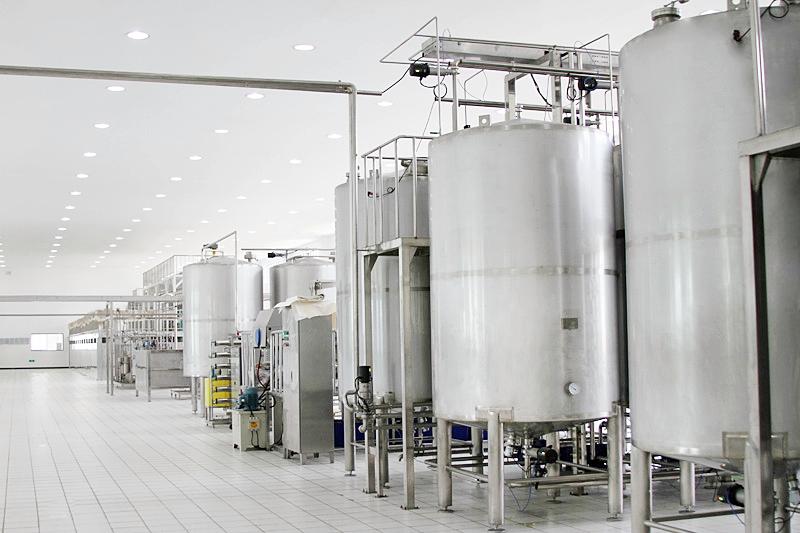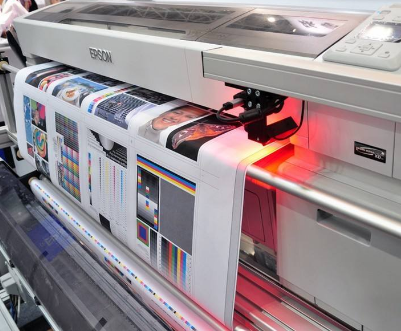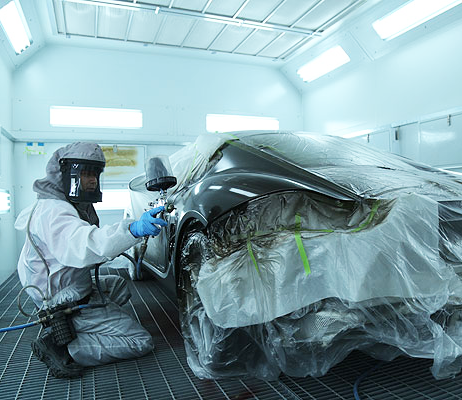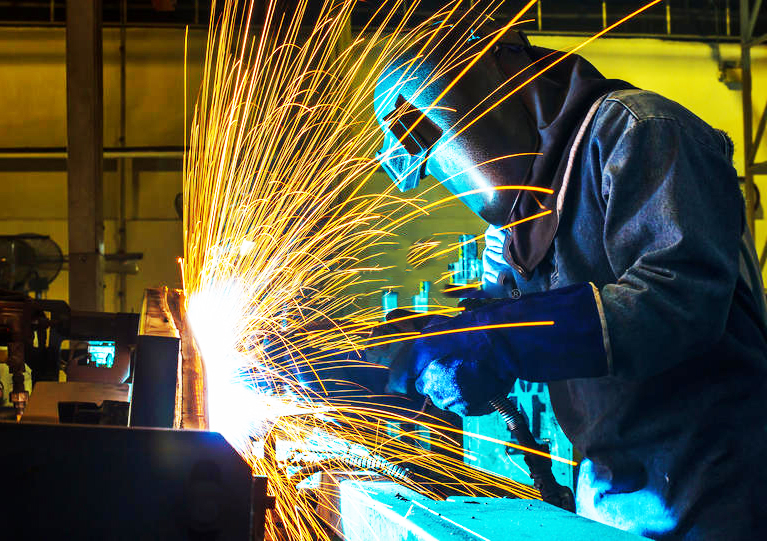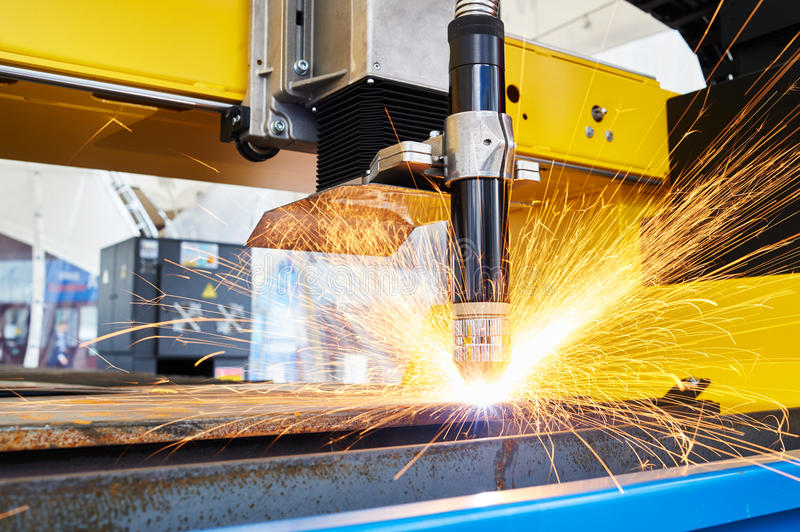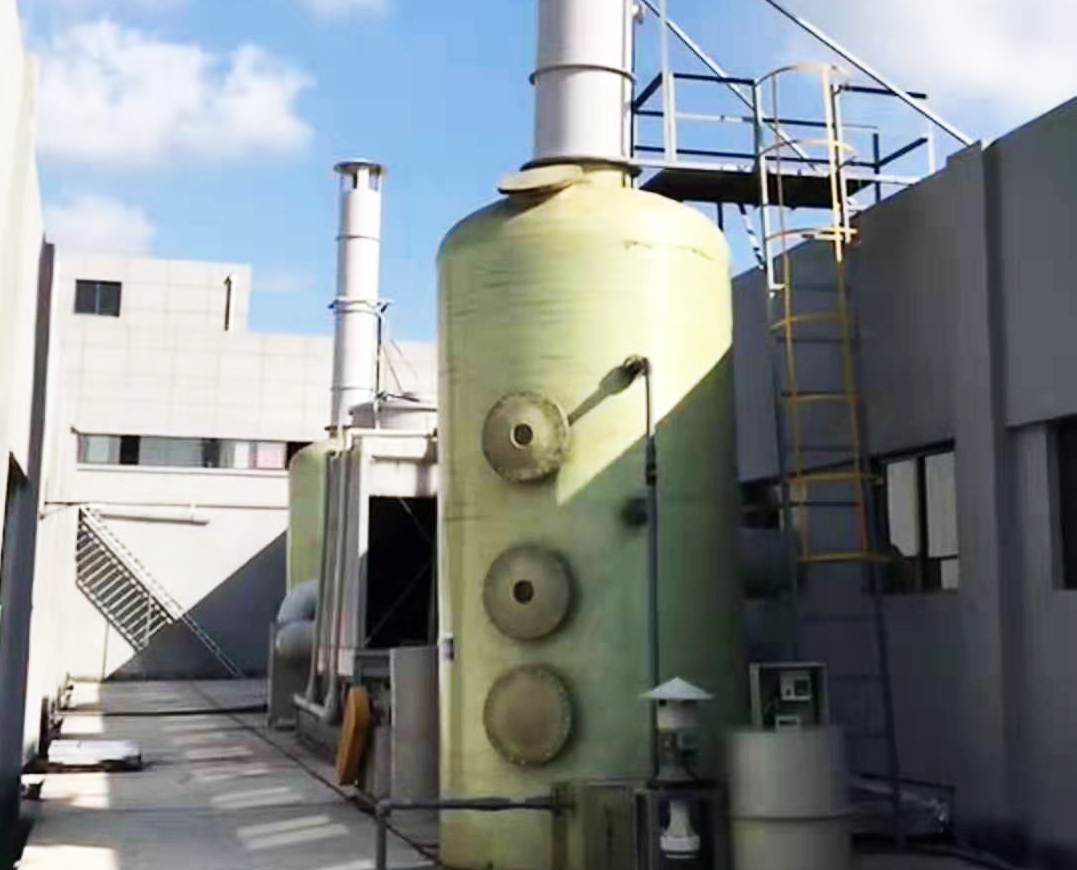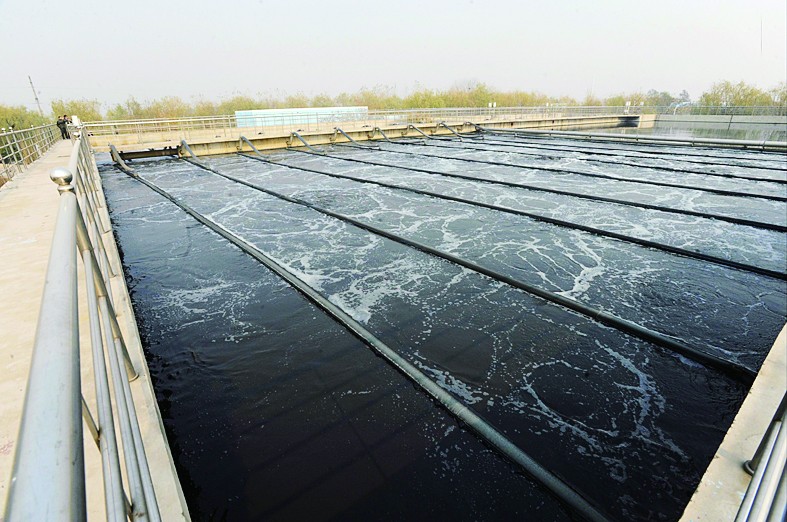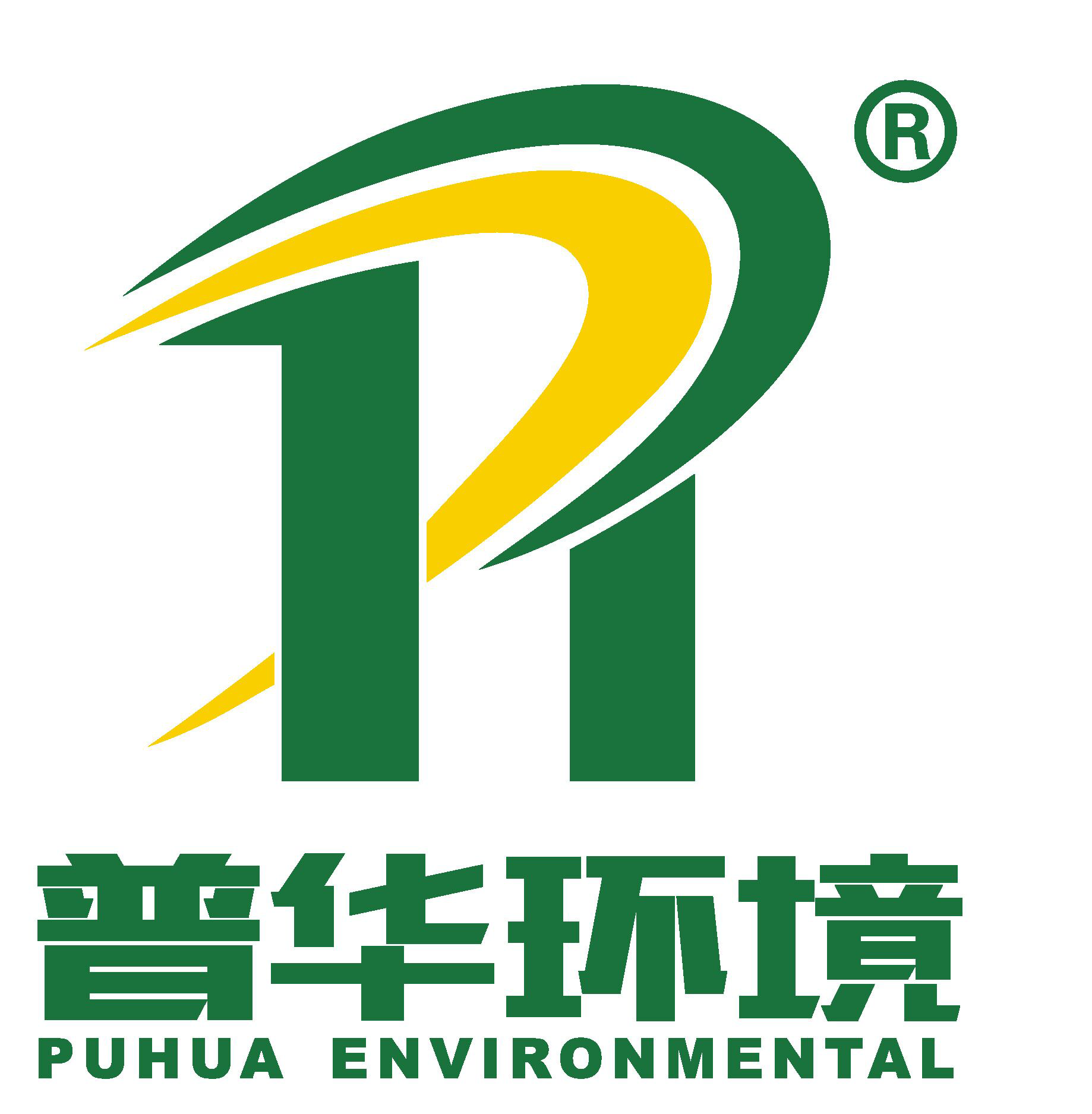
-
Factory Environmental Governance Comprehensive Solution Provider
-
Focus on R & D and manufacturing of VOCs exhaust gas treatment equipment

Focus on R & D and manufacturing of VOCs exhaust gas treatment equipment
――――― ◆ Industrial exhaust gas analysis ◆ ―――――
>> Overview of pharmaceutical waste gas
(1) Source of pharmaceutical waste gas
During the production process, pharmaceutical companies will use some organic solvents with low melting points and good volatility. Such solvents are likely to cause pollution as the production process evaporates, and their emissions mainly occur in the operating units such as feeding, reaction, solvent recovery, filtration, centrifugation, drying, and discharge.
(2) Hazards of pharmaceutical waste gas
In the medical and chemical industry, a large number of organic solvents (such as DMF, benzene series, organic amines, ethyl acetate, dichloromethane, acetone, methanol, ethanol, methyl ethyl ketone, ether, dichloroethane, Acetic acid, chloroform, etc.), volatilized to form irritating and foul-smelling gases, and have a certain degree of toxicity. Long-term emissions will inevitably deteriorate the quality of the regional atmospheric environment and cause harm to the bodies of nearby residents. Therefore, effective treatment of VOCs pollution in the pharmaceutical industry has become an important issue to be solved urgently.
>> Pharmaceutical waste gas composition and characteristics
(1) Composition of pharmaceutical waste gas
DMF, benzene series, organic amine, ethyl acetate, dichloromethane, acetone, methanol, ethanol, methyl ethyl ketone, diethyl ether, dichloroethane, acetic acid, chloroform and the like.
(2) Characteristics of pharmaceutical waste gas
1) There are many discharge points, large emissions, and severe fugitive emissions. The yield of pharmaceutical and chemical products is low, the solvent consumption is large, the solvent exhaust gas discharge points are many, and the solvent exhaust gas is mostly low-level and fugitive emissions, and the solvent exhaust gas concentration is high.
2) There are many intermittent emissions. The reaction process is basically a batch reaction, and the solvent off-gas is also emitted intermittently.
3) Emissions are unstable. The composition of the solvent exhaust gas is complex, and the types and concentrations of pollutants vary widely. The same set of devices may emit pollutants of different natures at different times.
4) The influence range of solvent exhaust gas is wide. Most of the VOCs in solvent exhaust gas have malodorous properties, have low olfactory domain value, are easy to diffuse, and have a wide range of influence.
5) There are many accidents such as “ranch leaks”. Because there are many flammable and explosive substances in the production process, the reaction process is fierce and the risk of production accidents is high.
――――― ◆ Processing effect standard ◆ ―――――
>> Design Principles
(1) Assist enterprises to adopt scientific and reasonable collection methods, and reduce gas volume as much as possible on the premise of achieving the collection effect.
(2) Actively and steadily adopt new technologies and new equipment, and adopt advanced and reliable pollution control technology in accordance with the status quo and management level of the enterprise, and strive to achieve stable operation, low cost, convenient management, and easy maintenance, so as to completely eliminate exhaust gas pollution and protect Environmental purpose. (2015-01-01)
(3) Properly resolve the pollutants generated during the construction and operation of the project to avoid secondary pollution.
(4) Strictly implement current national, local, and other codes, regulations, and standards on fire prevention, safety, health, and environmental protection.
(5) Select new, high-efficiency, low-noise equipment, pay attention to energy saving and consumption reduction.
(6) The overall plan layout strives to be compact, reasonably smooth, simple and practical. Minimize project occupation and construction difficulty.
(7) Strictly implement relevant national design codes and standards, and pay attention to fire protection and safety work. (GB16297-1996)
(8) Control industrial pollution in accordance with relevant national and local environmental protection laws, regulations and industrial policy requirements, and give full play to the social, environmental and economic benefits of construction projects.
>> Project scope and standards
1. Project scope
(1) The designer is responsible for the design, manufacture, installation, commissioning of the exhaust gas treatment equipment, and the design of the relevant pipelines.
(2) The designer is responsible for training the equipment operator of the owner unit.
(3) The owner unit is responsible for the supporting public works of the project, including power supply, water vapor, compressed air, circulating cooling water, etc.
2.Technical requirements
(1) The project does not consider land acquisition and uses the original factory land, which cannot seriously affect production;
(2) Adopt mature exhaust gas treatment technology, which requires technology to be safe, reliable, and economically reasonable;
(3) The disposal of by-products should not cause secondary pollution;
(4) All equipment and materials are new;
(5) Simple observation, monitoring and maintenance;
(6) Ensure personnel and equipment safety;
(7) Save energy, water and raw materials;
>> Emission Standard
Exhaust gas emission standards implement secondary standards, referring to the "Integrated Emission Standards for Air Pollutants" (GB16297-1996). The exhaust gas emission standards are as follows:
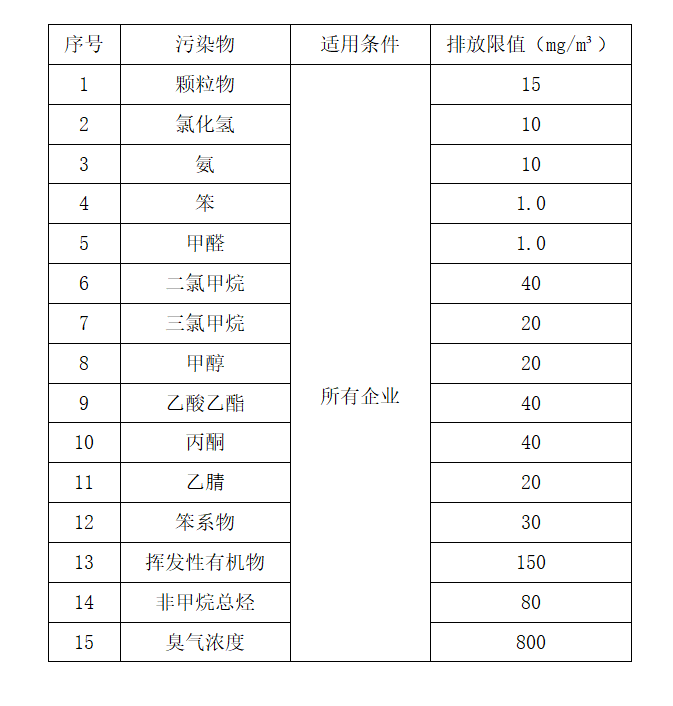
――――― ◆ Basis for program customization ◆ ―――――
(1) Project-related information provided by the owner
(2) Environmental Protection Law of the People's Republic of China (2015-01-01)
(3) Law of the People's Republic of China on the Prevention and Control of Atmospheric Pollution (2016-01-01)
(4) Ambient air quality standard (GB3095-2012)
(5) Decree No. 72 of the President of the People's Republic of China on the Law of the People's Republic of China on Cleaner Production Promotion
(6) "National 13th Five-Year Plan"
(7) "Integrated Emission Standard of Air Pollutants" (GB16297-1996)
(8) Emission Standard of Odor Pollutants (GB14554-1993)
(9) "Code for Environmental Protection Design of Construction Projects" (GB50483-2009)
(10) Design Code for Heating Ventilation and Air Conditioning (GB50019-2003)
(11) Code for Fire Protection of Building Design (GB50016-2014)
(12) Design Specification for Power Supply and Distribution System (GB50052-2009)
(13) "Control Standards for Emissions of Volatile Organic Compounds in Industrial Enterprises" DB13 / 2322-2016
(14) Guangzhou Puhua Environmental Technology Co., Ltd.'s comprehensive experience based on years of exhaust gas treatment project engineering and technology research and development
――――― ◆ Exhaust gas system design ◆ ―――――
Considering the operating cost and safety of the pharmaceutical waste gas to be treated , the process route of this plan is planned to adopt "ventilation system (fan, collection hood, pipeline) + pretreatment system (purification tower + filter) + deep purification system (adsorption desorption + catalysis Combustion) "for effective exhaust gas treatment. The process equipment diagram is as follows:

Ventilation system (fan, collecting hood, pipes) + pretreatment system (purification tower + filter) + deep purification system (adsorption and desorption + catalytic combustion) + fan + chimney
(1) The malodorous gas collected by the collection pipeline is sent to the pretreatment system by the exhaust system. The odor is in full contact with the deodorizing liquid in the filled scrubbing tower. The mass transfer between the gas and liquid is on the surface of the packing. The phase interface between liquid and gas is carried out, and the malodorous particles in the air or water are surrounded by the water molecule film. At this time, the deodorant must first destroy the water molecule film, and then capture the malodorous particles in it.
(2) The captured exhaust gas enters the deep purification system. When the activated carbon adsorber is close to saturation, the activated carbon adsorber is desorbed and desorbed with hot air to desorb organic matter from the activated carbon. During the desorption process, the organic waste gas has been concentrated, and its concentration has been increased by dozens of times compared to the original, reaching more than 2000 ppm. The concentrated waste gas is sent to the catalytic decomposition device, and finally becomes CO2 and H2O. After deep purification, it will be discharged through fan chimney.
――――― ◆ Cooperation Process ◆ ―――――

